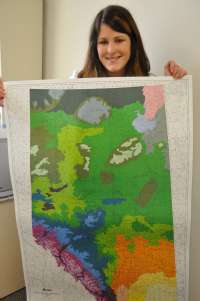Reforestation practices may be lagging behind climate change

A University of Alberta study is sounding a warning about forestry practices in North America, claiming that climate change is already rendering established planting guidelines obsolete.
“We’ve found that trees are already lagging in adaptation to climate change and are not performing as they should,” said Laura Gray, a PhD student in the Department of Renewable Resources. “We need to change the way we manage our forests today if we want to maximize production.”
Gray’s findings were based on two studies she conducted for her thesis, exploring planting guidelines in the forest-rich regions of western North America, including parts of Alberta, British Columbia, Montana, South Dakota and Wyoming, seeking ways to adapt to climate change that is leaving forests less productive or vulnerable to disease and pests like the Mountain Pine Beetle.
The related findings are published in the latest issues of the scientific journals Public Library of Science and Ecological Applications.
Using computer models, Gray and her colleagues analyzed the landscape of western North America, attempting to find optimal climate habitat for tree species under observed warming trends and under future climate change scenarios. Based on that data, changes could be made to what type of tree seed is planted where.
Currently, legislated forestry practices dictate that seed for reforestation cannot be transferred from designated zones where seed has been collected, but, said Gray, climate change is altering tree habitat so that the existing zones may not be the best places for current and future reforestation efforts.
“A lot of forest management strategies are based on data we have from the 1960s and 1970s, but the climate has definitely changed since then,” said Gray. Her research has revealed that aspen trees—used for oriented strandboard and pulp—are already climactically mismatched for their current seed zones. In turn, that has led to much less forest productivity over the last decade, Gray said. “It’s already happening, and we are behind the times.”
“We know the climate is changing and we are trying to determine where we can pick up seed and move it, so that trees are more closely matched to their optimal environments, creating better productivity over their lifetime.”
The studies recommend that various tree seeds be planted in multiple zones that show a close climatic match for the future. “In many cases, we have found that those locations range well beyond the current seed zones.”
The research also showed that trees suited to warm and dry climates—such as southern Alberta and some areas of the United States—will likely be the best choices for the forests of tomorrow. “Trees best adapted to those conditions are going to be really useful in the future,” Gray said.
And while the trend in forestry is to look ahead 80 to 100 years, Gray’s research recommends against that, suggesting instead that projections can realistically only stretch to 2020 or so. “The adaptation strategies are limited to the short-term horizon, because it is difficult to really predict the climate beyond that time. A better strategy is to focus on seeds that are climate-matched for 10 years from now.”
Gray has made several presentations on her findings to the forestry industry, and said while the research represents a significant departure from contemporary forest management practices, changes are necessary.
“We really are suggesting a change to the way things are managed today, and while this research can’t fix the problem of climate change, we can certainly make suggestions on how to mitigate impacts for the forestry sector.”
Provided by University of Alberta















